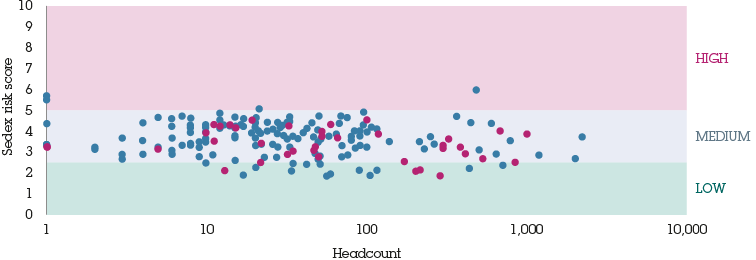What is the issue?
We are strengthening our approach to identifying and managing social, environmental and governance risks in our supply chain, to reflect increased client interest in this area. Improving oversight and understanding of our supply base also opens up opportunities to consolidate our procurement and reduce costs.
The large numbers of suppliers we work with and the diversified nature of procurement within WPP means we have to prioritise our efforts. We are currently focused on tier-one suppliers, those with whom we have a direct contractual relationship. Our approach includes: improving our understanding and oversight of supply chain risks; clearly communicating our expectations to all suppliers; and engaging more closely with suppliers whose products and services and/or location could present a higher risk to WPP and our clients.
How we manage
Our Group Procurement Leadership Team (PLT) is responsible for managing sustainability in our supply chain. Improving social and environmental performance is a key objective for all PLT members. The PLT works closely with our Group and operating company procurement teams to ensure that they understand and implement our sustainability requirements. It communicates on sustainability issues through quarterly reporting and regular cross-Group sourcing team activities and newsletters.
We are strengthening our approach to managing social, environmental and governance risks in our supply chain, to reflect increased client interest
Around half of our procurement spend is with WPP preferred suppliers that provide goods and services to our companies such as IT, travel, telecommunications, professional services, facilities and IT management. Many of these contracts are negotiated centrally and this is where we focus many of our Group-level sustainability efforts. The other half of our spend is primarily made up of goods and services used in client work. These contracts are usually smaller and negotiated by budget holders within our companies.
All WPP companies and Group procurement professionals are expected to take the following steps when selecting and managing suppliers:
- Conduct due diligence to assess whether suppliers pose a potential financial or reputational risk to WPP or its clients.
- Assess operational, commercial and sustainability criteria.
- Apply our anti-bribery and corruption policies.
- Have suppliers read and sign the WPP Code of Business Conduct.
- Include a right-to-audit clause in purchase orders where appropriate.
Our approach is governed by the WPP Code of Business Conduct and Group Procurement Policy. In 2014, we created a supplier portal, ‘How we buy’, on our main website with information on our policy and approach for existing and prospective suppliers.
With many different individuals and companies making procurement decisions it can be challenging to track spend with suppliers and monitor performance. We have implemented an online spend analytics system that enables us to monitor around 65% of our total spend with suppliers across 12 of our largest markets. This makes it easier to track spend with each supplier company across different parts of our business, helping us identify opportunities to reduce costs, consolidate our supply base and better integrate sustainability.
Supplier selection and risk management
Our standards
We evaluate all potential new suppliers against a set of business requirements before they can become a WPP supplier. These include assurance of supply, quality, service, cost, innovation and sustainability. Our sustainability criteria cover six areas: policy, senior responsibility, materiality and issues identification, reporting, supply chain and anti-bribery and corruption.
Once selected, business partners and suppliers are asked to sign a copy of the WPP Code of Business Conduct (wpp.com/wpp/about/how-we-buy/) to confirm they will abide by its principles. Our expectations of suppliers are explained in the Code, including requirements relating to labour practices (such as wages, anti-harassment and discrimination and health & safety), human rights (including no child, forced or bonded labour), social impacts (such as anti-bribery and corruption) as well as other sustainability criteria.
We have identified areas where breaches of our Code could have a potentially significant impact on WPP’s reputation or that of our clients – advertising production and data collection
Targeted supplier risk assessments
The growing importance of sustainability issues to our clients and to our own business means we are taking a broader approach to identifying and managing risks in our supply chain, with more focus on managing ethical, social and environmental risks. Reflecting this, we have identified a number of areas in our supply chain where breaches of our Code could have a potentially significant impact on WPP’s reputation or that of our clients. These are advertising production and data collection.
To help us identify and manage risks in these areas, we select a number of key suppliers based on factors such as spend, volume of goods and services purchased, location and their strategic value to the business. Selected suppliers are asked to complete a self-assessment questionnaire, and to confirm they have read and understood the WPP Code of Business Conduct.
The self-assessment questionnaire is provided by Sedex, the not-for-profit membership organisation which works to share sustainability data across supply chains. It covers four areas: employment practices, health and safety, business ethics and environmental management. Responses are analysed using the Sedex risk tool, enabling us to assess the level of potential sustainability risk associated with each supplier. In 2014, we engaged with 52 key suppliers covering £140 million in annual spend (approximately 10% of our total spend on advertising production and data collection).
Size and risk category of suppliers assessed in 2014

- Suppliers assessed in 2013
- Suppliers assessed in 2014
Engaging with advertising production suppliers
Our advertising production supply chain involves many small companies and costs for these services are passed onto clients. We carried out an initial pilot with 400 suppliers in this area in 2013, and this year we began the process of rolling out our approach to our top advertising production suppliers through The Bridge APB, WPP’s new advertising production initiative.
In 2014, we engaged 20 suppliers in the UK and the US with a combined annual spend of £90 million. We spent time communicating our standards through introductory workshops and the suppliers were required to complete the Sedex self-assessment questionnaire. Results show that all suppliers are either low or medium risk, with the majority of suppliers carrying a medium sustainability risk as defined by Sedex.
Based on the issues identified during this process, we will hold further supplier workshops in 2015 and train suppliers on the practical steps they can take to align with our Code of Business Conduct. We will also conduct audits for selected higher-risk suppliers.

Tom Kinnard
Chief procurement officer, WPP
“Our clients expect us to manage social and environmental risks in our supply chain. By working with suppliers and improving oversight of standards in key areas, we can meet client expectations, align our procurement with our values, create efficiencies and reduce costs to the business”
Engaging with data collection suppliers
We work with a number of suppliers who collect, manage and store consumer and client data on behalf of WPP companies and our clients. It is essential that all these suppliers have the right data security and privacy standards in place to protect consumer privacy and to reduce legal and contractual risks to our companies and our clients.
In 2014, to gain a better understanding of risks in this area of our supply chain, we ran a pilot project covering 32 data collectors and brokers in the UK and the US that supply data to Kantar, KBM and Xaxis and represent more than £50 million in annual spend.
Suppliers were asked to read and sign the WPP Code of Business Conduct and our new Data Code of Conduct and complete the Sedex self-assessment questionnaire and a WPP-designed data security and privacy survey. This survey was based on the WPP Data Health Checker, the tool that we use to manage these risks internally. Areas covered included supplier standards for collection, use, storage and transfer of data, physical security measures, testing, access controls and data security accreditations and certifications.
The results showed that all the suppliers carry a medium sustainability risk as defined by Sedex. We are using these findings to make informed decisions about data management in our supply chain.
Read more about our approach to privacy and data security.
Supporting our sustainability objectives
By integrating sustainability into procurement decisions, we also support progress on our other sustainability objectives, particularly in the areas of employment standards, diversity and environmental management.
Green goods and services
We encourage our operating companies to use WPP preferred suppliers that we have identified as providing goods and services with improved environmental credentials, see Environment.
Carbon emissions in our supply chain
We undertook new analysis of carbon emissions in our supply chain this year, which will enable us to work with suppliers on this issue. See Scope 3: Understanding our wider carbon impact.
Supplier diversity
Developing a diverse supply chain, including sourcing from small businesses and those owned by women and minorities, helps us to respond effectively to the requirements of our diverse customer base and boost innovation and creativity. Our companies already have a diverse supply base and look for opportunities to increase the number of diverse suppliers they work with.